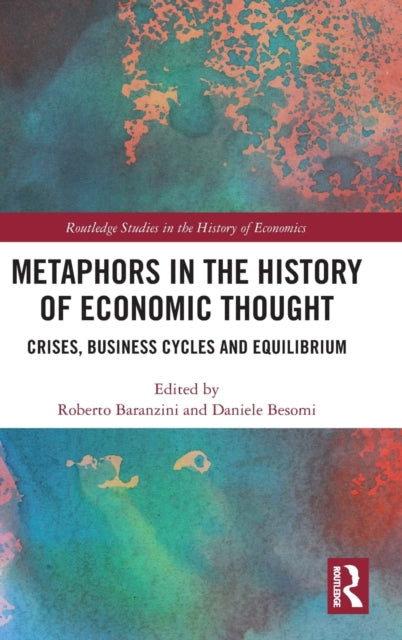Shulph Ink
Metaphors in the History of Economic Thought: Crises, Business Cycles and Equilibrium
Metaphors in the History of Economic Thought: Crises, Business Cycles and Equilibrium
YOU SAVE £6.96
- Condition: Brand new
- UK Delivery times: Usually arrives within 2 - 3 working days
- UK Shipping: Fee starts at £2.39. Subject to product weight & dimension
Bulk ordering. Want 15 or more copies? Get a personalised quote and bigger discounts. Learn more about bulk orders.
Couldn't load pickup availability
- More about Metaphors in the History of Economic Thought: Crises, Business Cycles and Equilibrium
Metaphors in the History of Economic Thought: Crises, Business Cycles, and Equilibrium explores the evolution of economic theorizing through the lens of metaphors, focusing on key thinkers and schools of thought from the Second World War to the 1980s.
Format: Hardback
Length: 290 pages
Publication date: 25 August 2022
Publisher: Taylor & Francis Ltd
Metaphors have played a significant role in shaping the evolution of economic thought throughout history, providing a rich and evocative language to describe complex economic phenomena. In the book "Metaphors in the History of Economic Thought: Crises, Business Cycles, and Equilibrium," edited by renowned scholars, the reader is taken on a journey through the use of metaphors in economic analysis.
The book is structured into three parts, each exploring a different aspect of economic phenomena through the lens of metaphors. The first part examines the use of metaphors in describing economic crises, such as financial crashes, economic downturns, and recessions. The contributors analyze how metaphors such as "crisis" and "crash" have been employed by different thinkers and schools of thought to convey the urgency and severity of these economic events. They also explore how metaphors can help us understand the underlying causes and mechanisms of economic crises, such as the role of financial institutions, market volatility, and consumer behavior.
The second part of the book focuses on metaphors used to describe business cycles and economic growth. The contributors examine how metaphors such as "cycle" and "growth" have been employed by economists to explain the ups and downs of economic activity over time. They explore how these metaphors can help us understand the factors that drive economic growth, such as innovation, investment, and human capital, as well as the challenges and risks associated with economic cycles.
The third part of the book examines metaphors used to describe economic equilibrium and stability. The contributors analyze how metaphors such as "balance" and "stability" have been employed by economists to describe the state of the economy where supply and demand are in balance and economic growth is sustainable. They also explore how metaphors can help us understand the factors that contribute to economic instability, such as inflation, unemployment, and economic shocks.
One of the key strengths of this book is its international panel of contributors, who bring a diverse range of perspectives and expertise to the analysis of metaphors in economic thought. The contributors hail from various countries and academic disciplines, including economics, linguistics, and philosophy. This diversity of perspectives ensures that the book offers a comprehensive and interdisciplinary understanding of the role of metaphors in economic analysis.
Another notable feature of the book is its focus on economic literature up to the Second World War. While the use of metaphors in economic work has seen a resurgence since the 1980s, the book recognizes the importance of understanding the historical context in which these metaphors emerged. By examining the use of metaphors in economic analysis during this period, the book provides valuable insights into the evolution of economic thought and the development of different economic schools of thought.
In conclusion, "Metaphors in the History of Economic Thought: Crises, Business Cycles, and Equilibrium" is a groundbreaking work that offers a fresh and insightful perspective on the evolution of economic thought through the use of metaphors. The book provides a comprehensive and interdisciplinary understanding of the role of metaphors in economic analysis, and its insights will be of interest to advanced students and researchers in the history of economic thought, economics, and language.
Weight: 710g
Dimension: 234 x 156 (mm)
ISBN-13: 9780367701062
This item can be found in:
UK and International shipping information
UK and International shipping information
UK Delivery and returns information:
- Delivery within 2 - 3 days when ordering in the UK.
- Shipping fee for UK customers from £2.39. Fully tracked shipping service available.
- Returns policy: Return within 30 days of receipt for full refund.
International deliveries:
Shulph Ink now ships to Australia, Belgium, Canada, France, Germany, Ireland, Italy, India, Luxembourg Saudi Arabia, Singapore, Spain, Netherlands, New Zealand, United Arab Emirates, United States of America.
- Delivery times: within 5 - 10 days for international orders.
- Shipping fee: charges vary for overseas orders. Only tracked services are available for most international orders. Some countries have untracked shipping options.
- Customs charges: If ordering to addresses outside the United Kingdom, you may or may not incur additional customs and duties fees during local delivery.


